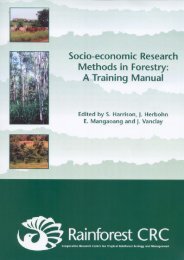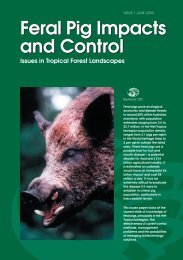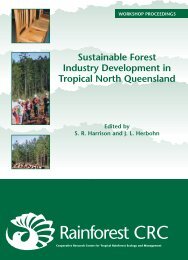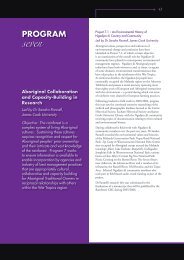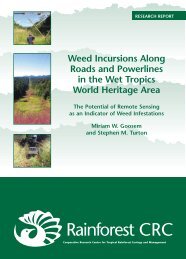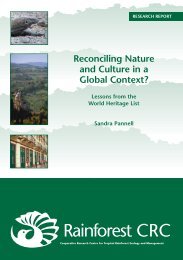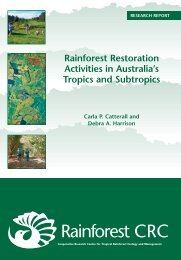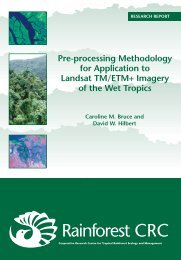Reconciling Nature and Culture in a Global Context? - Rainforest ...
Reconciling Nature and Culture in a Global Context? - Rainforest ...
Reconciling Nature and Culture in a Global Context? - Rainforest ...
You also want an ePaper? Increase the reach of your titles
YUMPU automatically turns print PDFs into web optimized ePapers that Google loves.
<strong>Reconcil<strong>in</strong>g</strong> <strong>Nature</strong> <strong>and</strong> <strong>Culture</strong> <strong>in</strong> a <strong>Global</strong> <strong>Context</strong>?Lessons from the World Heritage ListAUSTRALIAN HERITAGE AND THE COLONIAL EXPERIENCEThe issue of recognis<strong>in</strong>g a ‘heritage that hurts’ (Uzzell <strong>and</strong> Ballantyne 1998) is one that manyformer colonies are still grappl<strong>in</strong>g with as they come to terms with <strong>and</strong> try to reconcile someof the more shameful episodes <strong>in</strong> their recent past. In Australia, for example, while the legalrecognition of native title attempts to redress contemporary Aborig<strong>in</strong>al dispossessionresult<strong>in</strong>g from the colonial imposition of the concept of terra nullius, for the most part thiscolonial past rema<strong>in</strong>s a ‘hidden history’ (Bird Rose 1991). When Aborig<strong>in</strong>al cultures areacknowledged as part of the ‘nation’s heritage’ or are recognised as World Heritage, it is notbecause they have somehow survived more than 200 years of European colonisation.Unlike Macau, there are few <strong>in</strong>stances <strong>in</strong> Australia of restor<strong>in</strong>g <strong>and</strong> preserv<strong>in</strong>g thearchitectural products of the encounter between Indigenous people <strong>and</strong> European colonists.Comparison with Macau <strong>and</strong> other former colonies <strong>in</strong>scribed on the World Heritage List hasobvious implications for future nom<strong>in</strong>ations by the Government of Australia <strong>in</strong>volv<strong>in</strong>gIndigenous cultural heritage. It is certa<strong>in</strong>ly time to reth<strong>in</strong>k the relationship between heritage<strong>and</strong> the ‘colonial experience’ if we are to progress beyond the view of Australian coloniall<strong>and</strong>scapes as a picturesque artistic legacy, epitomised by the Heidelberg School (Taylor1995), or the presentation of colonial spaces as surviv<strong>in</strong>g ‘palaces’ of empire, as epitomisedby the recently-listed (2004) Royal Exhibition Build<strong>in</strong>g <strong>and</strong> Carlton Gardens.If Macau represents one of the first <strong>and</strong> longest-last<strong>in</strong>g <strong>in</strong>teractions between East <strong>and</strong> West,then the <strong>in</strong>troduction of the ‘Reserve System’ by colonial authorities <strong>in</strong> Queensl<strong>and</strong> <strong>in</strong> 1896can make similar claims <strong>in</strong> the history of Indigenous <strong>and</strong> colonial encounters. Ostensiblyestablished to ‘protect’ Aborig<strong>in</strong>es from European <strong>and</strong> Ch<strong>in</strong>ese settlers <strong>and</strong> the allegeddebilitat<strong>in</strong>g moral <strong>in</strong>fluences of these two societies (Meston 1895: 24), the Queensl<strong>and</strong>system was the first of its k<strong>in</strong>d <strong>in</strong> Australia <strong>and</strong> variations of it were soon enacted <strong>in</strong> otherstates. So-called ‘protection’ entailed the mass <strong>and</strong> forced removal of Aborig<strong>in</strong>al people fromtheir traditional homel<strong>and</strong>s to one of the newly established settlements. Prior to theestablishment of the Government’s reserves, a number of church-run mission stationsalready existed, the first of these be<strong>in</strong>g set up <strong>in</strong> the 1870s <strong>in</strong> south-east Queensl<strong>and</strong>(Department of Aborig<strong>in</strong>al <strong>and</strong> Isl<strong>and</strong>ers Advancement 1982). In the Wet Tropics region,Yarrabah 55 was established by the Church of Engl<strong>and</strong> <strong>in</strong> 1892; Bloomfield River Mission was<strong>in</strong>itially a government settlement established <strong>in</strong> 1886, but then taken over by the LutheranMission Council of South Australia <strong>in</strong> 1887; Mona Mona Mission was founded by the SeventhDay Adventist Church <strong>in</strong> 1913; while the government-run Hull River Aborig<strong>in</strong>al Settlementbegan operat<strong>in</strong>g <strong>in</strong> 1914 (loc. cit.). By 1948, 18 Aborig<strong>in</strong>al <strong>and</strong> Isl<strong>and</strong>er reserves, missions,<strong>and</strong> settlements had been established <strong>in</strong> North Queensl<strong>and</strong> <strong>and</strong> on Cape York Pen<strong>in</strong>sulaalone (loc. cit.) 56 . As previously mentioned, Yarrabah <strong>and</strong> Wujal Wujal (formerly BloomfieldRiver Mission), together with the Mona Mona Reserve, were <strong>in</strong>corporated <strong>in</strong>to the boundariesof the Wet Tropics World Heritage Area (DASETT 1987). While no longer reserves ormissions, today Yarrabah <strong>and</strong> Wujal Wujal cont<strong>in</strong>ue to support large Aborig<strong>in</strong>al communities,while Djabugay people are redevelop<strong>in</strong>g the former mission site of Mona Mona.Most Aborig<strong>in</strong>al people liv<strong>in</strong>g <strong>in</strong> Queensl<strong>and</strong> have some form of direct or mediatedexperience of the reserve system as part of what it meant to live under the Act <strong>in</strong> then<strong>in</strong>eteenth <strong>and</strong> twentieth century 57 . Today, the architectural rema<strong>in</strong>s of the mission days atplaces like Yarrabah, Wujal Wujal <strong>and</strong> Mona Mona are salient rem<strong>in</strong>ders of the <strong>in</strong>justices of55 Yarrabah was formerly known as Cape Grafton <strong>and</strong> also as the ‘Bellenden Ker Mission’.56 In the 1960s, Aborig<strong>in</strong>al Reserves were also established at Ravenshoe <strong>and</strong> Mal<strong>and</strong>a <strong>in</strong> the WetTropics region.57 In its various manifestations, The Aborig<strong>in</strong>als Protection <strong>and</strong> Restriction of the Sale of Opium Act of1897 controlled Aborig<strong>in</strong>al lives <strong>in</strong> Queensl<strong>and</strong> until 1984 (Bottoms 1999: 87).59




